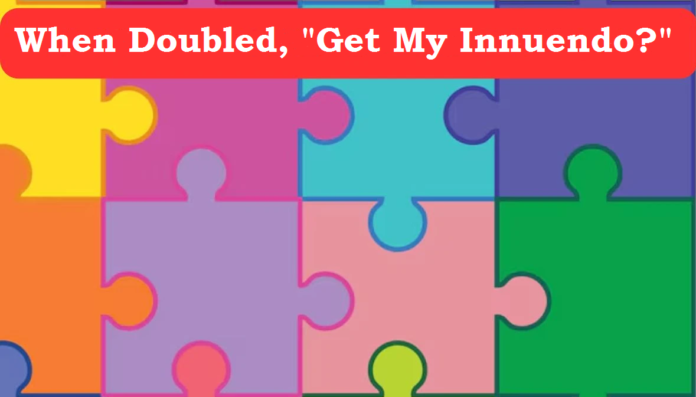Understanding the phrase “when doubled get my innuendo” requires delving into the fascinating world of language, wordplay, and innuendos. This article will explore the linguistic nuances, cultural significance, and practical applications of innuendos in communication.
What is an Innuendo?
An innuendo is a figure of speech where the intended meaning is often implied rather than explicitly stated. It relies on the context and the audience’s ability to read between the lines. Innuendos can be humorous, provocative, or even offensive, depending on the intention behind them and the perception of the audience.
The Origins of Innuendos
Innuendos have a long history in literature and speech. They are often used in satire and comedy to subtly criticize or mock without direct confrontation. The word “innuendo” itself comes from the Latin word “innuere,” which means “to nod to” or “to hint.”
The Role of Innuendos in Communication
Innuendos can serve various purposes in communication. They can lighten the mood, add humor, or convey messages that are too sensitive to express openly. Understanding and using innuendos effectively requires a good grasp of language and cultural nuances.
Decoding “When Doubled Get My Innuendo”
The phrase “when doubled get my innuendo” is a playful example of wordplay. Let’s break it down to understand its meaning and implications.
The Significance of Doubling
Doubling in language refers to the repetition of words or sounds. This can create emphasis, rhythm, or a comedic effect. In the context of innuendos, doubling can enhance the hidden meaning, making the innuendo more apparent to the listener.
Examples of Doubling in Innuendos
- Double Entendre: This is a common form of innuendo where a phrase has two interpretations, one of which is often risqué or humorous. For example, “She has a way with words” can imply that she is either eloquent or flirtatious, depending on the context.
- Puns: Puns are another form of doubling where a word with multiple meanings is used to create a playful innuendo.
Crafting Your Own Innuendo
Creating an effective innuendo involves understanding the subtleties of language. Here are some tips:
- Know Your Audience: Ensure that the innuendo will be understood and appreciated by your audience.
- Be Subtle: The best innuendos are not too obvious. They should make the listener think and decode the hidden meaning.
- Use Wordplay: Puns, double entendres, and other forms of wordplay can enhance the impact of your innuendo.
The Cultural Impact of Innuendos
Innuendos are prevalent in various forms of media, including literature, film, and music. They reflect cultural attitudes and can influence social interactions.
Innuendos in Literature
Many classic works of literature are rich with innuendos. Shakespeare, for instance, is known for his clever use of double entendres. In “Much Ado About Nothing,” he writes, “Shall I, wasting in despair, die because of a woman’s fair?” which can be interpreted in multiple ways.
Innuendos in Film and Television
Innuendos are often used in film and television to add layers of meaning to dialogue. Comedy shows like “Friends” and “The Simpsons” frequently employ innuendos to create humor that appeals to both adults and children.
Innuendos in Music
Music is another domain where innuendos thrive. Many song lyrics contain subtle (or not-so-subtle) innuendos that add depth to the storytelling. For example, the song “Little Red Corvette” by Prince uses car imagery to convey a message about a romantic encounter.
The Psychology Behind Innuendos
Understanding why we use and appreciate innuendos can be intriguing. It involves exploring human psychology and social behavior.
The Appeal of Innuendos
Innuendos appeal to our love for puzzles and hidden meanings. They engage the brain more actively than straightforward language, making the communication more memorable and enjoyable.
Innuendos and Social Bonding
Using innuendos can strengthen social bonds. Shared understanding of an innuendo can create a sense of intimacy and camaraderie among those in the know. It can also serve as a social filter, distinguishing between in-group and out-group members.
Innuendos and Humor
Humor is often rooted in the unexpected, and innuendos provide that element of surprise. They can defuse tension and create a lighter atmosphere, making conversations more enjoyable.
Conclusion
The phrase “when doubled get my innuendo” encapsulates the playful and intricate nature of language. Innuendos are a powerful tool in communication, capable of adding humor, depth, and subtlety to our interactions. By understanding and mastering the art of innuendos, we can enhance our linguistic skills and connect more meaningfully with others. In exploring the world of innuendos, we discover not just the hidden meanings in words but also the richness and complexity of human communication. So next time you hear or use an innuendo, take a moment to appreciate the cleverness and cultural significance behind it.
Read more interesting articles on Digitalnewsalerts.



